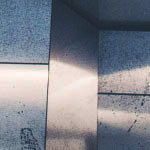The Fabricate 2014 international conference was held in Zürich, from February 12 -14. Architecture researchers and practitioners explored and discussed the impact of digital design and fabrication processes on architecture, engineering, design, construction, manufacturing, software and material design.
Session chair Professor Philippe Bloch (ETH) presented the outcome of design build workshops conducted in Australia with Architect Melonie Bayl-Smith, (Universtiy of Technology), Tim Schork (Monash Art Design and Architecture). Additionally, the D1 tower in Dubai designed by Australian firm Innovarchi was presented by German architect Hanno Stehling from Design to Production, showing new parametric driven fabrication of the four timber canopies skirting the tower.
I attended the conference and caught up with University of Technology (UTS) Adjunct Professor Melonie Bayl-Smith:
JC: The work of quite a few Australians were presented or mentioned at the ETH Fabricate 2014, including yourself, Dave Pigram (Supermaneouvre), Innovarchi and Danny Hills’ product ‘FormaTech’. Why do you think that innovative products, projects and fabrication work is being presented internationally but not locally?
MBS: To be honest, I’m not sure how much more ‘digitally engaged’ other countries or regions are than Australia. But it’s true that projects and people interested in digital experimentation seem to receive little credence beyond interested individuals, informed academic institutions and manufacturers. Perhaps this is because in Europe, the key makers of the machines and robots utilised in such experimental making and fabrication are local, and therefore have more immediacy and accessibility for support and R&D activities. Also, the building industry is notoriously conservative, so novel explorations and experimentation are often treated as an oddity unless proven to deliver ‘knowable’ benefits in the construction process.
JC: How do you see the topic of ‘fabrication’ being re-integrated with architecture education in Australia when the focus at some of the Architecture schools are on urban design and planning?
MBS: I’m not sure fabrication was ever integrated in the first place, but certainly on the whole, architecture schools in Australia could take a more innovative, integrated approach to teaching construction and making to architecture students. This could occur via more design/build studios piggy-backed with research intents, live projects with real clients and detailed modelling electives and workshops. Fabrication has a wide scope for application beyond the shiny pavilions that are often seen as the epitome of ‘digital fabrication’.
JC: Some of the large scale, well funded architecture practices in Sydney don’t have space to make models, let alone the prospect of a fabrication lab or workshop. Do you think architecture practice in Australia can regain some of the lost knowledge of ‘design through making’ by investing in this?
MBS: The capital cost of basic digital fabrication equipment, plus training staff and having a place to house an in-house fablab are often raised as barriers to establishing such facilities, particularly within architectural practices. However, design through making extends the architect’s range of expression and design processes and coupled with digital fabrication techniques can assist in producing quick prototypes, models or experimenting with new materials or design ideas. I can see that where the larger practices have established in-house studio or research groups that ‘fablabs’ are the next logical step to support built projects.
JC: Should the architecture practices in Australia start their own ‘fablabs’ and engage the public in the making of architecture?
MBS: Seeing the success of the MIT ‘Fablab’ network across the world proves the opportunity provided by these facilities to connect and building bridges with the general community. With an innate spatial sensibility and the opportunity to ‘spread the word’ about expertise that architects wield, it would be hard to see how local ‘fablabs’ could go wrong in furthering the causes of good design, a respect for making and exposing architecture to new markets and users.
Fabricate 2014 is organized in cooperation with the Bartlett School of Architecture, University College London and was hosted by the Chair of Architecture and Digital Fabrication at ETH Zurich.
Janine Campbell.
Image: Fabricate 2014.

